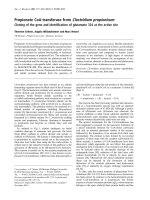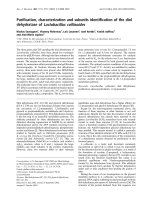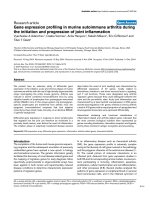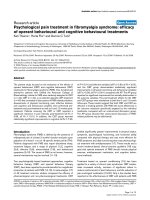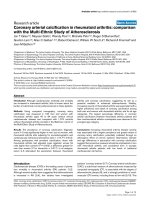Báo cáo y học: "Inhaled nitric oxide in persistent pulmonary hypertension of the newborn refractory to high-frequency ventilatio" ppsx
Bạn đang xem bản rút gọn của tài liệu. Xem và tải ngay bản đầy đủ của tài liệu tại đây (115.95 KB, 4 trang )
Inhaled nitric oxide in persistent pulmonary hypertension of the
newborn refractory to high-frequency ventilation
Saleh Al-Alaiyan and Edward Neiley
Background: This study was designed to evaluate the effect of nitric oxide (NO)
on the management of neonates with severe persistent pulmonary hypertension
refractory to high-frequency oscillatory ventilation.
Methods: The birth weight and the gestational age of infants were
3125.5±794g (mean±SD) and 39±2.4 weeks, respectively. All neonates were
ventilated for an average of 137.5min (range 90–180min) prior to NO therapy.
The mean oxygenation index (OI) of all neonates prior to NO was 46.3±5
(mean±SEM). NO was initially administered at 20 parts per million (ppm) for at
least 2h and increased gradually by 2ppm to a maximum of 80ppm.
Results: Eighteen infants (75%) responded and six (25%) did not respond to
the treatment. Three neonates died in the responding group, while all the non-
responders died (P=0.0001). The survival rate was 62.5% among all neonates.
NO significantly decreased OI (P<0.0001) and improved the arterial/alveolar
(a/A) oxygen ratio (P<0.0001) within the first 2h of NO therapy in 61.1% of the
responders. However, the OI and the a/A oxygen ratio remained almost the same
throughout the treatment in the non-responders and the non-survivors.
Conclusion: Inhaled NO at 20ppm, following adequate ventilation for 2h
without significant response, could be used to identify the majority of the non-
responders in order to seek other alternatives.
Address: King Faisal Specialist Hospital and
Research Centre, Riyadh, Saudi Arabia.
Correspondence: Dr Saleh Al-Alaiyan, King Faisal
Specialist Hospital and Research Centre,
Department of Pediatrics, P.O. Box 3354, MBC-
58, Riyadh 11211, Saudi Arabia.
Tel.: +966 1 442 7761; fax: +966 1 442 7784
Keywords: neonates, pulmonary hypertension,
nitric oxide, high-frequency ventilation
Received: 16 March 1998
Revisions requested: 24 July 1998
Revisions received: 31 January 1999
Accepted: 12 February 1999
Published: 15 March 1999
Crit Care 1999, 3:7–10
The original version of this paper is the electronic
version which can be seen on the Internet
(). The electronic version may
contain additional information to that appearing in
the paper version.
© Current Science Ltd ISSN 1364-8535
Research paper 7
Introduction
A wide range of life-threatening lung diseases are charac-
terized by compromised capacity of the lung to match
ventilation and perfusion. This results in poor oxygena-
tion of arterial blood and significant hypoxemia. Pul-
monary hypertension and poor myocardial function often
play a role in the pathophysiology of pulmonary disease
[1]. Several vasodilator agents have been shown to
decrease pulmonary vascular resistance, but their use was
limited by concomitant decreases in systemic vascular
resistance and worsening of intrapulmonary shunt [2].
Recently, selective pulmonary vasodilation with inhala-
tional nitric oxide (INO) has been demonstrated in both
clinical and experimental settings [3–5].
This pilot study was conducted to evaluate the effect of
INO in the management of neonates with severe persis-
tent pulmonary hypertension refractory to high-frequency
oscillatory ventilation.
Methods
Subjects
Between October 1994 and June 1997, 24 consecutive
neonates with persistent pulmonary hypertension of the
newborn (PPHN) who failed high-frequency oscillatory
ventilation were enrolled in this study. The diagnosis of
PPHN was made clinically and confirmed by echocardio-
gram (either right-to-left or bidirectional flow at the ductal
or arterial level, or estimated pulmonary pressures from a
tricuspid regurgitation jet, being greater than two-thirds of
the systemic arterial pressures). The studied neonates had
birthweights of 3125.5±794g (mean±SD), and gestational
ages of 39±2.4weeks (mean±SD). There were 12 females
and 12 males, and 22 were born outside the hospital. All
neonates were ventilated for an average of 137.5min
(range 90–180min) prior to INO therapy with 3100A high-
frequency oscillatory ventilator (HFOV; Sensor Medics,
Yorba Linda, California, USA). Metabolic alkalosis was
induced with a bicarbonate infusion. Sedation with mor-
phine and/or midazolam and neuromuscular blockade
with pancuronium were used. Synthetic surfactant
(Exosurf Neonatal, The Wellcome Foundation Ltd,
London, UK) was administered to all neonates with respi-
ratory distress syndrome (RDS) and meconium aspiration
syndrome (MAS). Dopamine and dobutamine were used
to maintain a mean arterial pressure between 45 and
55mmHg.
Study protocol
Neonates were enrolled after informed consent was
obtained from parents. At enrollment, postductal arterial
blood samples were drawn for determination of pH, blood
gas tensions, and methemoglobin saturation (270 Co-
oxime, Ciba-Corning, Diagnostics, Medfield, Massachu-
setts, USA) 10min prior to the treatment with INO and
every 2–4h thereafter. The mean oxygenation index of all
neonates [OI = mean airway pressure × fractional inspired
concentration of oxygen (FiO
2
)/post-ductal partial pres-
sure of arterial oxygen (PaO
2
)] during high-frequency
ventilation and before starting INO was 46.3±5
(mean±SEM). The NO gas (AHG, Jeddah, Saudi Arabia)
used in this study was certified at a concentration of
800ppm NO with <1% contamination by other oxides of
nitrogen. NO gas was introduced into the ventilator circuit
via an adaptor positioned on the inspiratory port of the
Fisher and Paykel humidification chamber. Thus, NO was
mixed with the bias flow gas of the oscillator and subse-
quently delivered to the neonate via the inspiratory limb
of the ventilator circuit. The resulting concentration of the
inhaled NO and NO
2
was verified in-line by using an elec-
trochemical sensor (Pulmonox, Tofield, Alberta, Canada).
Exhaled gas was scavenged; the oxygen concentration was
analyzed continuously before it reached the neonate’s
endotracheal tube. Nitric oxide was initially administered
at 20ppm for at least 2h. If there was no response while
the neonate was on high ventilatory support and FIO
2
of
1.0, INO was increased gradually by 2ppm to a maximum
of 80 ppm. If there was a response, INO was maintained at
20ppm and FIO
2
was gradually decreased to 0.6, provided
the PaO
2
was 80–120mmHg. Nitric oxide then was
weaned to discontinuation. Ventilatory parameters there-
after were weaned and HFOV was replaced by a conven-
tional ventilator. An arterial/alveolar oxygen (a/A) ratio less
than 0.22 was used to define failure of HFOV and INO
therapy, if INO reached 80ppm on high ventilatory
support.
Statistical analysis
Statistical analysis was performed with the assistance of
the Department of Biostatistics. Normally distributed con-
tinuous variables were analyzed with the Student’s t-test.
Variables without a normal distribution were analyzed
with the Wilcoxon signed rank test. This study has been
approved by the Department of Pediatrics Research Com-
mittee and the King Faisal Specialist Hospital and
Research Centre’s Research Advisory Council.
Results
Of the 24 consecutive neonates treated with both HFOV
and INO, 18 (75%) responded and 6 (25%) did not
respond to the treatment. Three neonates died in the
responding group, while all the non-responders died
(P=0.0001). The survival rate was 62.5% among all
neonates.
The underlying diseases of the responders and non-
responders are depicted in Table 1. In addition to severe
PPHN, six neonates had birth asphyxia, 13 had MAS,
three had congenital diaphragmatic hernia (CDH) and two
had RDS. Of the 13 neonates with MAS, 12 responded to
INO, while none of the infants with CDH responded to
INO therapy.
Inhalation of NO significantly decreased OI (P<0.0001)
and improved the a/A ratio (P<0.0001) within the first 2h
of INO therapy in 61.1% of the responders, and the
remaining responded gradually during the INO treatment.
However, OI and a/A ratio remained almost the same
throughout the treatment in the non-responders and the
non-survivors (Tables 2 and 3). Four of the responders
(two with MAS and two with RDS) became INO-depen-
dent and required phosphodiesterase inhibitor (dipyri-
damole) to wean them from INO. Tolazoline was
unsuccessfully attempted in two neonates in the referring
hospitals. Methemoglobin and nitrogen dioxide were
maintained below 5% during INO therapy. The average
age when INO was started was 2.6days (range 1–11days).
The mean duration of INO used in all neonates was
4.6days (range 1–10days). Three neonates responded to
INO but died of other causes. The first neonate had
severe intracranial hemorrhage, Klebsiella pneumoniae
sepsis, renal failure and, consequently, brain death. The
second neonate had Escherichia coli sepsis and interstitial
lung disease. The lung biopsy revealed a diffuse alveolar
8 Critical Care 1999, Vol 3 No 1
Table 1
The underlying diseases of all infants
Responders Non-responders
(n = 18) (n = 6)
Birth asphyxia/hypoxia 4 2
Meconium aspiration syndrome 12 1
Respiratory distress syndrome 2 0
Congenital diaphragmatic hernia 0 3
Table 2
Comparison between responders and non-responders
Responders Non-responders
(n = 18) (n = 6) P
Birth weight (g) 3180 ± 190.2 2970 ± 329.4 0.59
Gestational age (weeks) 39 ± 0.58 39 ± 1 0.96
OI pre INO 42.9 ± 5.8 56 ± 10 0.25
OI during INO 11.3 ± 3.5 39 ± 6 0.0007*
a/A pre INO 0.09 ± 0.008 0.071 ± 0.014 0.28
a/A during INO 0.315 ± 0.021 0.137 ± 0.063 0.0003*
OI, oxygenation index; a/A, arterial/alveolar oxygen ratio; INO,
inhalational nitric oxide. All values shown as mean ± SEM; *P < 0.05.
damage. The third neonate developed multiple pneuma-
toceles in both lungs and the lung biopsy showed prolifer-
ative phase of diffuse alveolar damage. Subsequent lung
tissue culture was positive for methicillin-resistant
Staphylococcal aureus.
Discussion
PPHN is a common endpoint of several very different
pathophysiological mechanisms. It is extremely important
to understand the underlying etiology of PPHN, as thera-
peutic interventions must be tailored to specific circum-
stances; for example, PPHN associated with hyaline
membrane disease should first be treated with surfactant
therapy.
Maintenance of adequate circulating blood volume, sys-
temic vascular resistance, and optimal lung inflation are
essential for the management of PPHN. High-frequency
ventilation has been introduced as a mode of therapy in
PPHN. There were no randomized studies of HFOV in
the management of infants with PPHN, but attention has
been focused on the potential of HFOV to reduce the
need for extracorporeal membrane oxygenation (ECMO).
A number of reports identify a number of infants who,
although referred for ECMO, survived without using this
type of intervention [6,7].
A comparison between HFOV and INO in reducing the
need for ECMO has been studied. Kinsella et al [8] com-
bined HFOV and INO in the treatment of infants with
hypoxic respiratory failure and PPHN who were ECMO
candidates. These authors found no difference in the need
for ECMO or death in the INO group compared with the
HFOV group, and they suggest that combined treatment
with INO and HFOV may improve outcome.
In this study, we found that 75% of infants with PPHN
who failed HFOV responded to INO therapy and 62.5%
survived to discharge. Recently, the NINOS Study Group
has conducted a study to evaluate whether INO would
reduce the incidence of death or the need for ECMO in
infants with hypoxic respiratory failure [9]. HFOV was
used in 55% of the infants. The authors found that treat-
ment with INO resulted in a significant reduction in the
combined incidence of death in less than 120 days or the
need for ECMO. Moreover, Roberts et al [10] studied 58
full-term infants with severe hypoxemia and PPHN who
were randomized to receive either INO or nitrogen. They
found that INO improved systemic oxygenation in these
infants and they suggest that INO may reduce the need
for more invasive treatment.
In this study, we found that 61.1% of the responders
responded within the first 2h after the initiation of INO
and their response sustained to the end of the treatment
and the remaining neonates showed a gradual response
throughout the course of INO. Similarly Goldman et al
[11] evaluated INO in a group of 25 severely hypoxic
term neonates and identified four patterns of response.
Two neonates did not respond, nine neonates who
responded well initially then failed within 24h, 11
neonates responded and sustained that response, and
three neonates responded to INO but required high
doses for prolonged periods of time. We also found that
25% failed INO therapy, most likely as a result of severe
pulmonary hypoplasia seen in CDH, and severe lung
damage due to severe hypoxia as in asphyxia and RDS. A
number of studies have noted a general lack of a sus-
tained improvement in oxygenation in response to INO
in the management of CDH [12–14]. In this study
ECMO was not used as an alternative therapy for the
INO non-responders because it was not available in our
hospital for neonates.
It has been observed that some infants who showed a dra-
matic response to INO developed a decrease in oxygena-
tion when INO was discontinued. This response may
reflect downregulation of endogenous nitric oxide syn-
thase activity secondary to the administration of exoge-
nous nitric oxide [15]. In addition INO may increase the
concentration of phosphodiesterase, which then degrades
cyclic GMP when INO is discontinued, resulting in vaso-
constriction. In this study, four infants became INO-
dependent and successfully weaned from INO following
the use of phosphodiesterase inhibitor (dipyridamole)
[16]. Study of the mechanism of INO dependency may
give insight into new therapies that augment the pul-
monary vasodilatory effect of INO and the activity of the
endogenous NO system.
In conclusion, the administration of INO at 20ppm, fol-
lowing adequate ventilation for a maximum of 2h without
significant response could be used to identify the majority
of the non-responders. In these situations, other means of
therapy, such as ECMO, could be considered.
Research paper Inhaled NO in neonatal pulmonary hypertension Al-Alaiyan and Neiley 9
Table 3
Comparisons between survivors and non-survivors
Survivors Non-survivors
(n = 15) (n = 9) P
Birth weight (g) 3362 ± 193.3 2736 ± 249.5 0.06
Gestational age (weeks) 39.5 ± 0.60 38.2 ± 0.78 0.20
OI pre INO 45.7 ± 6.5 47.3 ± 8.4 0.90
OI during INO 11.9 ± 4.5 28.84 ± 3.8 0.03*
a/A ratio pre INO 0.090 ± 0.009 0.076 ± 0.011 0.36
a/A ratio during INO 0.317 ± 0.026 0.193 ± 0.034 0.009*
OI, oxygenation index; a/A, arterial/alveolar oxygen ratio; INO,
inhalational nitric oxide. All values shown as mean ± SEM; *P < 0.05.
References
1. Calvin JE, Baer RW, Glantz SA: Pulmonary artery constriction pro-
duces a greater right ventricular afterload than lung microvascular
injury in the open chest dog. Circ Res 1985, 56:40–56.
2. Rondermacher P, Santak P, Becher H, Falke KJ: Prostaglandin E1
and nitroglycerin reduce pulmonary capillary wedge pressure but
worsen V/Q distribution in patients with adult respiratory distress
syndrome. Anesthesiology 1989, 70:601–609.
3. Frostell C, Fratacci MD, Wain JC, Jones R, Zapol WM: Inhaled nitric
oxide: a selective pulmonary vasodilator reversing hypoxic pul-
monary vasoconstriction. Circulation 1991, 83:2038–2047.
4. Kinsella JP, Neish SR, Shaffer E, Abman SH: Low dose inhalational
nitric oxide in persistent pulmonary hypertension of the newborn.
Lancet 1992, 340:819–820.
5. Roberts J, Polaner D, Lang P, Zapol W. Inhaled nitric oxide in per-
sistent pulmonary hypertension of the newborn. Lancet 1992, 340:
818–819.
6. Carter JM, Gerstmann DR, Clark EH et al: High-frequency oscillation
and extracorporeal membrane oxygenation for the treatment of
acute neonatal respiratory failure. Pediatrics 1990, 85:59–64.
7. Kohelet D, Perlman M, Kirpalani H, et al: High-frequency oscillation
in the rescue of infants with persistent pulmonary hypertension.
Crit Care Med 1988, 16:10–16.
8. Kinsella JP, Truog WE, Walsh WF, et al: Randomized, multi-center
trial of inhaled nitric oxide and high-frequency ventilation in
severe persistent pulmonary hypertension of the newborn. Pediatr
Res 1996, 139:252A.
9. The NINOS Study Group: Inhaled nitric oxide for near-term infants
with respiratory failure. N Engl J Med 1997, 336:597–604.
10. Roberts JD, Fineman JR, Morin FC, et al: Inhaled nitric oxide and
persistent pulmonary hypertension of the newborn. N Engl J Med
1997, 336: 605–610.
11. Goldman AP, Tasker RC, Haworth SG, et al: Four patterns of
response to inhaled nitric oxide for persistent pulmonary hyper-
tension of the newborn. Pediatrics 1996, 98:706–713.
12. The Neonatal Inhaled Nitric Oxide Study (NINOS) Group: Inhaled
nitric oxide and hypoxic respiratory failure in infants with congeni-
tal diaphragmatic hernia. Pediatrics 1997, 99:838–845.
13. Shah N, Jacob T, Exler R, et al: Inhaled nitric oxide in congenital
diaphragmatic hernia. J Pediatr Surg 1994, 29:101–115.
14. Henneberg SW, Jepsen S, Andersen PK, Pedersen SA: Inhalation of
nitric oxide as a treatment of pulmonary hypertension in congeni-
tal diaphragmatic hernia. J Pediatr 1995, 30:853–855.
15. Bult H, De Meyer GRY, Jordaens FH, Herman AG: Chronic exposure
to exogenous nitric oxide may suppress its endogenous release
and efficacy. J Cardiovasc Pharmacol 1991, 17 (suppl):S79–S82.
16. Al-Alaiyan S, Al-Omran A, Dyer D: The use of phosphodiesterase
inhibitor (dipyridamole) to wean from inhaled nitric oxide. Inten-
sive Care Med 1996, 22:1093–1095.
10 Critical Care 1999, Vol 3 No 1

